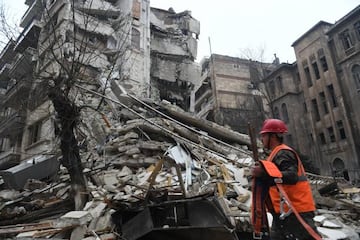WORLD NEWS
What caused the Turkey earthquake? A history of deadly quakes in the region
An earthquake of magnitude 7.8 struck central Turkey and northwest Syria killing more than 500 people and injuring hundreds more as buildings collapsed, triggering searches for survivors.

The death toll from Turkey’s deadly earthquake continues to rise with more than 500 confirmed as dead at the time of publication.
The disaster struck struck shortly after 04:00 am (local time) impacting the central area of Turkey and northwest Syria registering a magnitude of 7.8 on the Richter scale.
Monday’s quake which rocked both central Turkey and northwest Syria and was also felt in parts of Lebanon and Israel. Tremors were also felt in the Turkish capital of Ankara, 460 km (286 miles) northwest of the epicentre, and in Cyprus, where police reported no damage.
Monday’s earthquake was as powerful as that of 1939 which remains the most potent and deadly quake recorded in the northeast of the country (Izmit) which claimed over 30,000 lives.

What caused the Turkey earthquake?
Turkey is one of the most earthquake-prone countries in the world as it sits on the Anatolian Plate which borders two major faults as it shifts northeast against Eurasia. The North Anatolian fault crosses the country from west to east and the East Anatolian fault rests in the country’s southeastern region. This grinding has been instrumental in causing large earthquakes that moved progressively from east to west over a period of 60 years.
Turkey’s deadly quakes in the past
October 2011
The area of Van (close to the Iranian border) has been particularly badly affected by earthquakes over the decades with two quakes in October and November of 2011 causing the loss of more than 900 lives.
August 1999
A magnitude 7.4 earthquake that struck the western Turkish city of Izmit killed more than 17,000 people. The 1999 earthquake was part of a sequence along the North Anatolian Fault that started in 1939, causing large earthquakes that moved progressively from east to west over a period of 60 years.
November 1976
The 1976 Çaldıran–Muradiye earthquake occurred in November with the epicenter located near Çaldıran, 20 km northeast of Muradiye, in the Van Province of eastern Turkey. The earthquake had a magnitude of 7.3 with between 4,000 and 5,000 casualties.
December 1939
The quake in Turkey on December 27, 1939 registered 8.2 on the Richter scale and remains the most powerful one that has ever been recorded in the history of the country causing more than 30,000 lives to be lost in the 1939 Erzincan earthquake.
Follow live updates on the Turkey/Syria earthquake here






